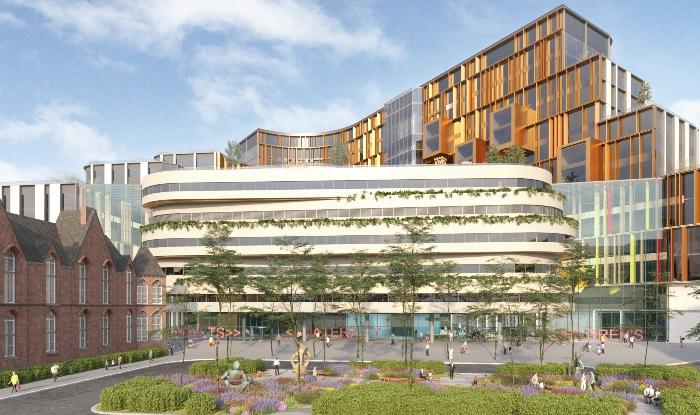Two new state-of-the-art hospitals for Leeds came a step closer today with the unveiling of the latest concept designs of the new buildings – inspired by the Yorkshire landscape.
The major interdisciplinary practice, BDP, has been appointed by Leeds Teaching Hospitals NHS Trust to lead the architectural design of its Hospitals of the Future programme, part of its long-term vision to transform healthcare facilities for patients and staff in Leeds and the wider region.
The new first design concepts take the new hospital development to the next stage but will still need detailed design development and will be used as the basis for further engagement over the next 12-18 months as the final design is agreed for the two new hospitals at Leeds General Infirmary. BDP has proposed a hospital structure that is shaped like the contours of the Yorkshire fells and dales, with a large island garden and play deck at its centre. Outdoor space and play areas were some of the facilities that children and young patients suggested in a design competition, held last year, which have inspired the architects with their latest concept.
The development of a new adults’ hospital, along with a new home for Leeds Children’s Hospital, is set to be one of the most significant healthcare projects in the UK.
For the first time in Leeds, a brand-new Leeds Children’s Hospital will bring all clinical services for children and young people under one roof. The new hospital will enable LCH to expand and meet the demand for highly specialised services in areas including cancer treatment, neurology, liver, kidney and bone marrow transplantation and congenital heart surgery.
Julian Hartley, chief executive of Leeds Teaching Hospitals NHS Trust, said: “The building of our two new hospitals is the most important development in Leeds city centre for a generation. And, in terms of hospital-based healthcare, it’s the most important development in the city centre since 1868, when Leeds General Infirmary was first built.
“It’s wonderful to see that BDP has listened to the feedback we’ve given them and have come up with these concept designs that are thoroughly patient focussed, and which place patient and staff wellbeing at the heart of our new hospitals. These concept designs give extensive access to daylight and greenery, and not only do they maximise wellness, but they also bring something of the dales into the city centre. These inspirational designs will see not only the creation of world class medical and research facilities, but also the creation of a landmark public building, of real architectural quality, of which Leeds can truly be proud.”
The trust is planning to commence construction in 2023, enabling us to align with the government’s New Hospital Programme and benefit from the collaborative approach of working at scale, allowing us to share our experience with other less developed schemes, in areas such as digital technology, sustainability and modern methods of construction.
By working in this collaborative way we will maximise the benefits and efficiencies, ensure delivery of state-of-the-art healthcare facilities for local patients and staff, whilst also representing value for money for the taxpayer. The Hospitals of the Future project is part of the government’s commitment to build 40 hospitals by 2030, backed by an initial £3.7 billion.
Dame Linda Pollard, chair of Leeds Teaching Hospitals NHS Trust, said: “We’re very proud of the progress we have made with the plans for our new hospitals, and we’re excited by the concepts put forward for what will be the most important development in Leeds city centre for many years.
“Digital technology and world-leading innovative techniques will be central to the services provided in the new hospitals whilst the old hospital estate will be redeveloped as part of the City’s Innovation District, bringing about direct and wider economic benefits of up to £11.2 billion in net present value terms and more than 3,000 jobs. This redevelopment of the old LGI site will also help us to preserve some beautiful buildings with significant history to their former glory.”

